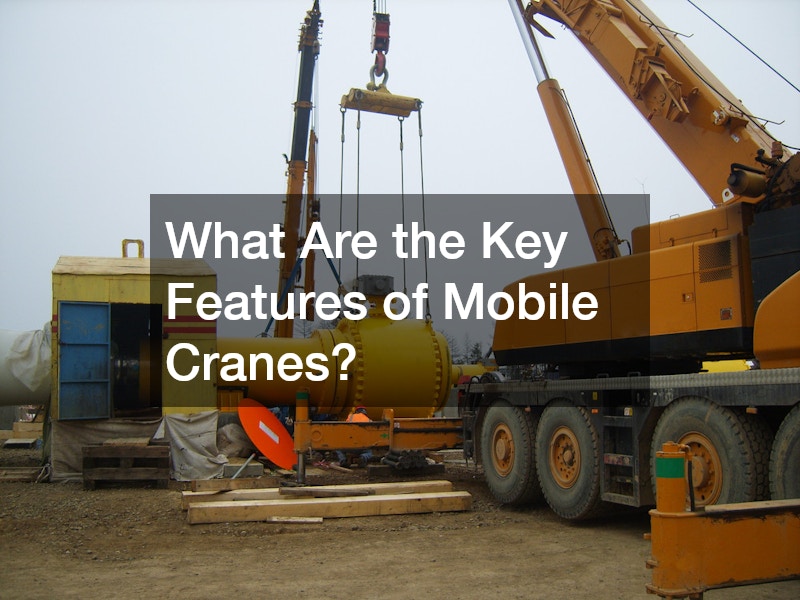Mobile cranes have become essential in modern construction, logistics and infrastructure development due to their versatility, power and ability to operate in diverse environments. Unlike traditional tower cranes that are fixed in position, mobile cranes offer the advantage of portability, making them suitable for projects that demand flexibility and efficiency.
Understanding the key features of mobile cranes can help construction managers, contractors and logistics operators make informed decisions about their equipment needs.
Mobility & Flexibility
One of the defining characteristics of a mobile crane is its ability to move easily between sites. This mobility allows construction teams to quickly reposition the crane without the need for disassembly or complex logistics. Most mobile cranes are mounted on wheeled or crawler platforms, allowing them to travel on roads or rough terrain depending on the model. This ability to transition from one location to another reduces downtime and enhances overall productivity.
The design of mobile cranes accommodates a variety of operational settings. They can work in tight urban spaces or remote rural locations without the need for extensive site preparation. Their adjustable outriggers provide added stability on uneven surfaces, making them especially valuable for infrastructure or civil projects that span large, varied landscapes.
Lifting Capacity & Reach
Another crucial feature of any mobile crane is its lifting capacity, which can range from a few tonnes to several hundred tonnes. This wide capacity range allows project managers to choose the appropriate crane model based on the specific requirements of a job. Some mobile cranes are designed for heavy-duty industrial use, while others are tailored for lighter construction tasks.
Modern mobile cranes often feature telescopic booms that extend vertically and horizontally to reach difficult or elevated areas. These booms are typically made of high-tensile steel to ensure strength and durability without adding excessive weight. The flexibility of the boom, often enhanced by hydraulic or mechanical extension systems, enables operators to lift materials over obstacles or across barriers with ease. This makes mobile cranes ideal for jobs such as erecting steel structures, placing HVAC systems on rooftops, or assembling wind turbines.
Advanced Control Systems
Technological advancements have significantly improved the performance and safety of mobile cranes. Many models are equipped with sophisticated control systems that allow operators to manage complex lifting tasks with precision. These systems include load moment indicators, which warn the operator if the crane is at risk of becoming unstable due to an excessive load or improper positioning. Additionally, some mobile cranes incorporate computerised sensors and remote control features to facilitate operations in hazardous or hard-to-reach environments.
The inclusion of programmable logic controllers (PLCs) and touchscreen interfaces has further modernised crane operations. These digital systems not only improve control accuracy but also help diagnose mechanical issues, schedule maintenance and ensure compliance with safety regulations. Enhanced operator feedback through digital displays and sensors contributes to a safer work environment and reduces the likelihood of human error.
Compact Design & Setup Efficiency
The compact design of mobile cranes makes them highly advantageous in congested work environments. Unlike tower cranes or larger stationary models, mobile cranes require minimal space for setup and operation. This is particularly beneficial on urban construction sites where space is at a premium and manoeuvrability is essential.
Most mobile cranes are designed for rapid deployment. Their components are integrated into a single unit, allowing for quick assembly and disassembly. Hydraulic systems enable the boom and outriggers to extend and retract smoothly, shortening setup times and reducing labour costs. Because the entire crane is self-contained, transport between job sites is straightforward, often requiring no more than a standard truck license for road travel.
Versatile Applications
The versatility of a mobile crane extends beyond construction. These machines are commonly used in industries such as shipping, mining, oil and gas and utilities. They can perform tasks like loading and unloading containers at ports, assembling large industrial components, or conducting emergency rescue operations following natural disasters. Their adaptability to different tasks makes them an invaluable asset across a wide range of sectors.
Additionally, the range of attachments and accessories available for mobile cranes increases their utility. These include different hook types, personnel baskets and lifting beams that allow the crane to accommodate a variety of lifting scenarios. The ability to switch between tasks with minimal modification makes mobile cranes a cost-effective solution for organisations that handle multiple project types.
Safety & Compliance Features
Safety is a paramount concern in any lifting operation and mobile cranes are equipped with numerous features to ensure secure handling. Anti-two block devices prevent the hook block from coming into contact with the boom tip, which could cause structural damage or a dropped load. Load charts, rated capacity limiters and emergency shut-off systems are standard inclusions that guide operators and protect workers on the ground.
Why Mobile Cranes Stand Out
In the ever-evolving world of construction and industrial logistics, mobile cranes have earned a reputation for their agility, strength and technological sophistication. Their ability to move between job sites, adapt to different environments and handle a range of lifting tasks makes them an indispensable tool. From lifting heavy steel beams on city skyscrapers to navigating rugged terrain in remote mining operations, the mobile crane continues to prove its value across countless applications. As technology continues to improve, so too will the capabilities of these machines, cementing their role as a cornerstone of modern heavy lifting solutions.









